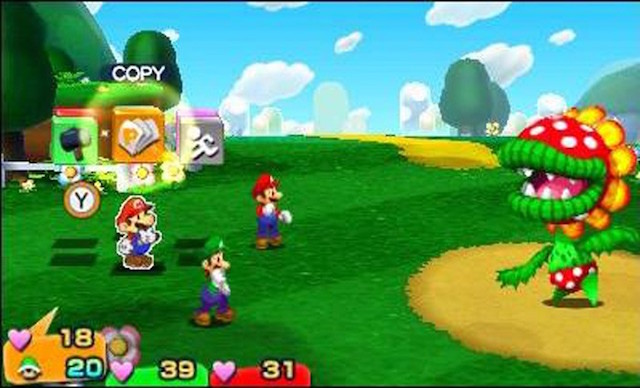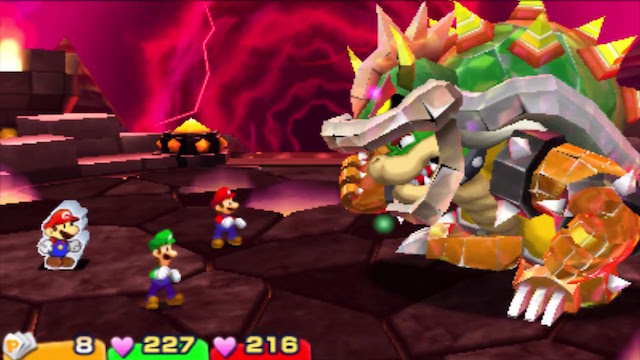Deep, fun battle system; clever overworld traversal; slick visuals; funny dialogue; Toadette!
Generic story; weak cast; bland environments
I really don’t understand the strongly negative response that some reviewers have been giving to Mario & Luigi: Paper Jam. Granted, it doesn’t reach the heights of some of the best entries in the series, like Bowser’s Inside Story and Superstar Saga. Yet, despite a so-so cast and generic environments, Paper Jam is still a highly enjoyable Mario RPG. The combat is easily the deepest and most satisfying yet seen from developer AlphaDream, and the dialogue is brilliant, as always. It’s imperfect, but Paper Jam is a worthwhile effort, nonetheless.
The game opens with the lovable, bumbling Luigi accidentally knocking a book off of a shelf in Peach’s castle. The book, as it turns out, is home to the world of Paper Mario and pals, and as its pages go cascading open, all of its paper residents are sent shooting out into the reality of the Mario and Luigi games. The premise is interesting enough, but sadly AlphaDream couldn’t resist leaning on the tired old plot line of Peach being captured by Bowser. I’ll concede that the appeal to fall back on this well-trodden storyline clearly came from the prospect of seeing a paper and “3D” version of each character interacting, which is funny, certainly, but in the Mario RPG games, I think it’s much wiser to keep the storylines as original as possible. It’s easier to get away with a barebones “Peach the hostage” plot in the platformers, but in a game like Paper Jam, where the story is so omnipresent, it just feels lazy.

Further compounding the issue, AlphaDream features a very stripped down cast in Paper Jam. Mario, Luigi, and Starlow are all prominent, but Paper Mario himself doesn’t even speak, which makes his addition more worthwhile from a gameplay perspective than a narrative one, and that’s not even mentioning the hordes of generic Toads and Lakitus featured throughout. Also, while it’s understandable that favorites like Fawful and Broque Monsieur might be omitted, there’s no one noteworthy to replace them, and it’s an absence that’s truly felt. Bowser, Peach, Bowser Jr., and their paper equivalents all chime in with some funny dialogue (a hallmark of the series), but by the end of the adventure it felt like something was missing from the story with so few notable cast members and a forgettable plot. I will say that it was awesome seeing Toadette get some much-needed fleshing out as the game’s resident inventor. Hopefully her profile only continues to rise in future Nintendo games.
While the story might be underwhelming, there’s no denying that the gameplay is completely on point in Paper Jam. From Super Mario RPG onward, the plumber’s RPGs have always employed a timing mechanic as part of an otherwise fairly standard turn-based battle system. Tap the attack button, then hit that same button again right before the attack lands in order to inflict more damage. It’s simple but immensely satisfying, and has returned for Paper Jam. What makes the Mario & Luigi series distinct from the Paper Mario games, however, is the unique way that buttons are assigned to each character in the party. “A” for Mario, “B” for Luigi, and in this game, “Y” for Paper Mario, all with corresponding uses for real-time dodging/countering and attacking (especially the zany, over the top Bros. attacks). It takes some true skill to master this battle system, though there are a number of ways to nerf the experience for less-experienced players that will help balance things out for longtime and new fans.
Enormous paper crafts are introduced in Paper Jam, which are piloted during elaborate boss battles. Toadette is the designer of the things, and in order to build them the player is tasked with collecting Paper Toads to act as handymen. There are a number of segments of gameplay interjected here that require taking a break from the normal grinding of fighting baddies to instead save the Toads, and these segues act as a welcome change of pace. Though saving the Paper Toads is required to proceed through the game, these interludes are brief enough that it doesn’t become tiring chasing after the small helpers. Once enough have been rescued, Toadette is able to then build her paper craft for the trio to use to defeat whichever enemy is blocking the way with its own, giant paper craft. These fights are basic arena battles, where the crafts are hurled at foes, with the intermittent need to refuel its energy by tapping along to the rhythm of a very rudimentary music game. These fights are even less frequent than the Toad hunts, which is a good thing; they’re fun for what they are (and look great), but don’t offer a deep enough experience to make them anything more than sheer spectacle.

The most creative gameplay beyond the battle system tends to involve exploring Paper Jam’s overworld, where the trio of plumbers can combine their skills to burrow into the ground, stretch and grab faraway polls and objects, and more. Getting from point A to B in this game is handled very much like an elaborate puzzle, and everything is rendered in a stunning visual style. Textures and lighting are like eyeball magnets, and the juxtaposition of Paper Mario characters and elements with the Mario & Luigi universe’s more three-dimensional aesthetic is pretty cool. Sadly, the great graphics engine (especially for character animations; Luigi and Mario ooze personality) is somewhat squandered on generic forest, desert, and snow locales. The scenery looks nice but ends up being unremarkable; with the Mushroom Kingdom so open for interpretation, it’s sad that AlphaDream played it safe with the look of Paper Jam’s geography.
Which perhaps is the best way to sum up Paper Jam as a game: safe. Too safe for its own good. The battle system is inventive and addicting, the graphics are lovely, and much of the dialogue is good for some genuine laughs, but at the end of the day Paper Jam doesn’t do enough to capitalize on its otherwise novel premise of merging the Mario & Luigi world with Paper Mario’s. Again, I’m not suggesting fans won’t have fun with this game; it will easily suck up many hours of playtime, for sure. I also still hold that it doesn’t quite deserve the ribbing it’s getting from some reviewers. Just know that the game falls short of the very high benchmarks set by previous series installments, but will entertain for as long as it’s plugged in and turned on. I hope that AlphaDream returns to the more daring approach it showed off in Dream Team for future Mario & Luigi games, but until then, Paper Jam shouldn’t be missed.




 ShareThis
ShareThis






Well, even though this gets mediocre reviews on other sites, still getting it. Have to have the complete collection.
I’ve played it just for a while. It’s fun in a way, but i was still hoping for a paper mario game. This is just mario & luigi game all over again XD